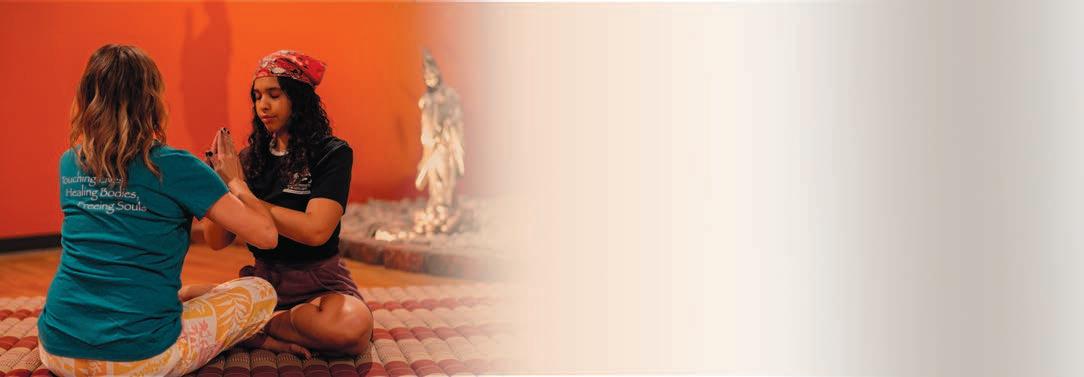




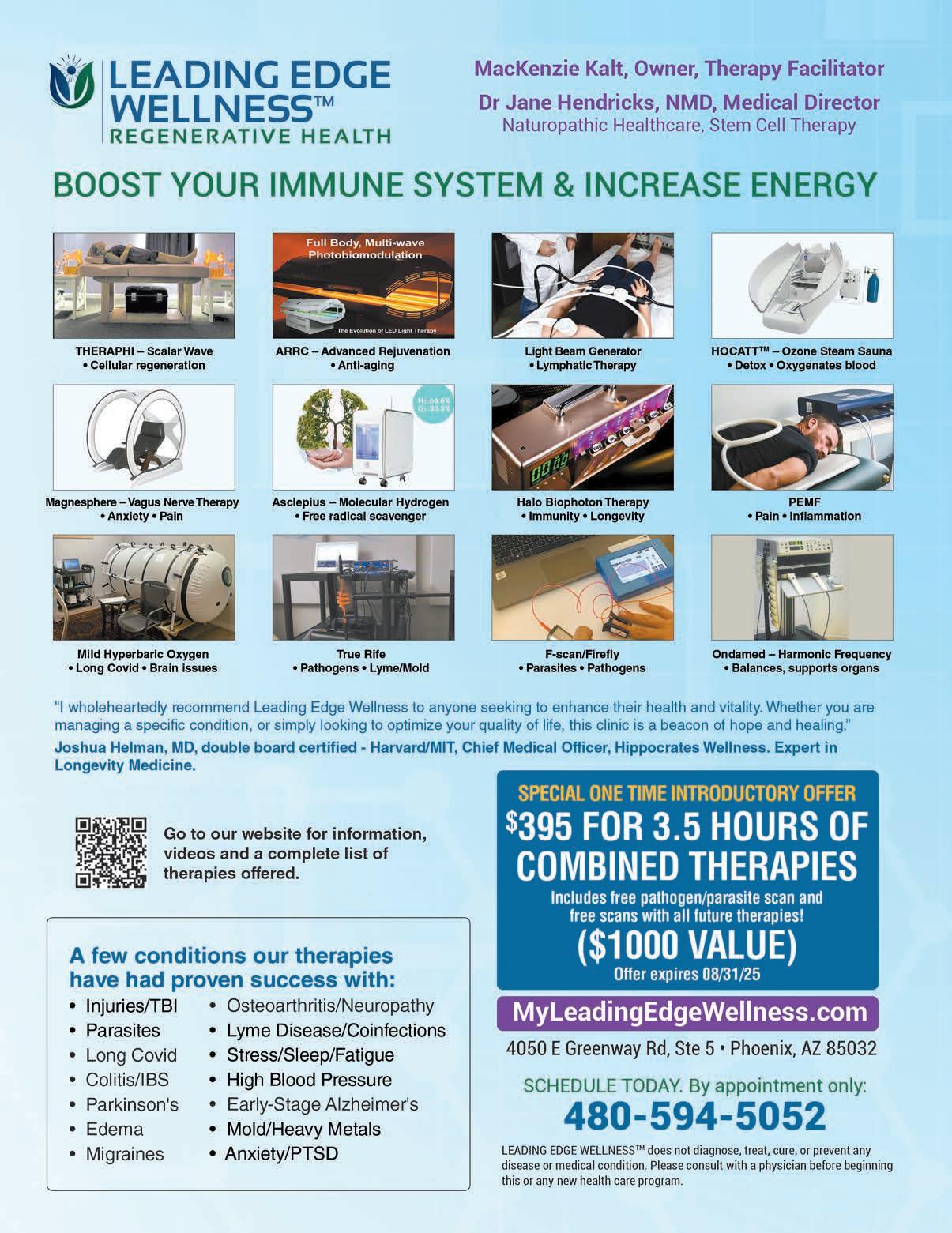
























Publisher Tracy Patterson, BSc, MES
Design & Production Vegetorium, LLC
Copy Editor Sara Gurgen, MS
Digital Platforms
Carolyn Coogan Locable
Natural Awakenings – Phoenix Tracy@NaturalAZ.com NaturalAZ.com
CEO Kimberly B. Whittle
COO Michael Bevilacqua
CMO Vee Banionis
Sr. VP Operations Brian Stenzler, DC
National Editor Sandra Yeyati
Editor Brooke Goode
Copy Editor Melanie Rankin
Print Production Specialist Kevin Rankin
Design Director Agnes Mazeikaite
Production Flip180
Executive Admin Julius Frago
Cover image
AdobeStock_586872747
© 2025 by Natural Awakenings. All rights reserved. Although some parts of this publication may be reproduced and reprinted, we require that prior permission be obtained in writing. Natural Awakenings is a free publication distributed locally and is supported by our advertisers. Please call to find a location near you or if you would like copies placed at your business. We do not necessarily endorse the views expressed in the articles and advertisements, nor are we responsible for the products and services advertised. Check with a healthcare professional regarding the appropriate use of any treatment.

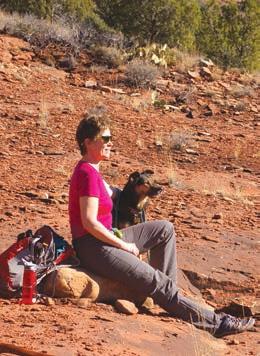
The Green Living article on page 26 in this edition reminded me of a rather strange event that occurred when we purchased the home we’re living in now.
It was a bit of a challenge setting up our furniture and decorating this home. We already had our furniture, knick-knacks and wall hangings, and weren’t planning to buy anything new.
Placing furniture in the odd-shaped living room, setting up the bedrooms, and even placing my trinkets around the house were all tasks I normally wouldn’t think twice about— just put what we have in the rooms and be done with it.
But not this time! The open-space living room and kitchen—each with a different type of flooring and divided by an angular boundary—made it incredibly difficult to place the furniture without it looking very odd. On top of that, the mantle-less fireplace in the corner didn’t work with any of our wall hangings.
Even the knick-knacks, some with more of a Southwest theme, didn’t suit the faintly Mediterranean interior, with its tile floor, rounded hallway entrance and pale green-gray paint we’d chosen for the walls.
I worked at it for what seemed like forever—moving furniture around, trying different combinations in each room, placing each little tchotchke here and there. At some point, I developed the sense that the house was actually “talking” to me: “No, do not use that knick-knack,” or “Yes, you can place that bookcase there.” It was the craziest sensation, and one I’d never experienced before. Creepy at first, but I eventually accepted it and just took the direction!
I didn’t bother lingering over how it was that our house seemed to have its own agenda for how things should go. We were more than pleased with the end result, and I decided I was happy for the guidance—I was even “allowed” to place our one purchase, a big Roman numeral clock, above the fireplace. Perfect!









Those interested in holistic health, personal growth and alternative wellness practices are invited to attend the Embracing Your Journey Expo on Saturday, September 6, from 10 a.m. to 5 p.m. at the New Vision Center for Spiritual Living, in Phoenix. Hosted by Purple Lotus Productions, the event brings together a wide range of holistic, wellness and metaphysical vendors in one convenient location.
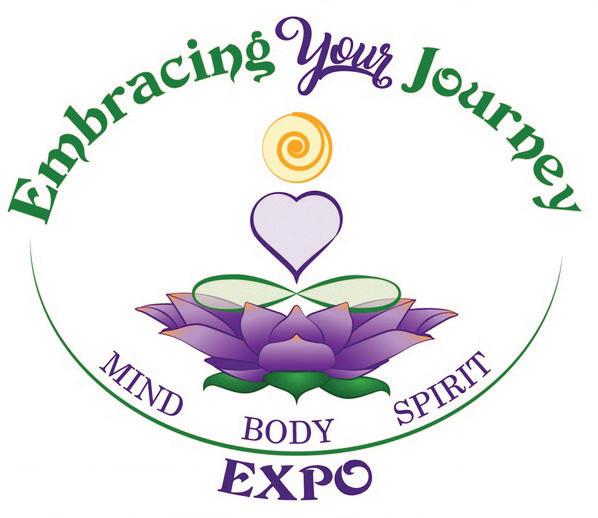
With more than 35 vendors, the expo offers attendees the opportunity to explore a variety of products and services, including massage, reiki, sound healing, natural bath and body care, essential oils, tarot and angel readings, affirmation tools and more. Designed as a welcoming space for both newcomers and seasoned wellness enthusiasts, the event highlights the abundance and prosperity of the fall season.
The venue provides a spacious indoor and outdoor setting, free parking, and a central location easily accessed from the Tatum Boulevard exit off the 101. Nearby restaurants add convenience for those planning to spend the day at the event.
Guests who purchase tickets in advance will receive a free gift at check-in. Additionally, the first 50 paid attendees to arrive will receive a swag bag.
Cost: $5 in advance or at the door; children 10 and under are free. Location: 18010 N. Tatum Blvd. For more information, visit EmbracingYourJourneyExpo.com. To purchase tickets, visit eyje-Sept06-25.eventbrite.com. See ad, page 14.
Advertorial
Menopause, which occurs at the end of a woman’s reproductive years, brings about changes in body composition and heightened health risks, including bone density loss, insulin resistance and an elevated propensity for cardiovascular disease. Notably, women that naturally enter menopause after age 55 have better health outcomes and a longer lifespan than those experiencing earlier menopause. Researchers and industry stakeholders are actively investigating ways to postpone its onset.
Yale University has devised an experimental procedure originally developed to preserve fertility for women undergoing cancer treatments. It involves surgically removing the outermost layer of the ovary, which contains hundreds of thousands of immature eggs, when a woman is in her late 30s. The tissues are cryogenically preserved for reimplantation years later as menopause approaches.
Columbia University is studying how to delay ovarian aging through the administration of low doses of an immunosuppressant drug, thus inhibiting a cellular pathway implicated in the aging process. Gameto, a biotechnology company dedicated to advancing treatment options for women, is conducting animal testing on engineered young ovarian support cells derived from stem cells. Celmatix Therapeutics is working on a drug designed to slow ovarian reserve depletion. Other researchers are advancing senolytic drugs engineered to selectively target and eliminate old, damaged cells.
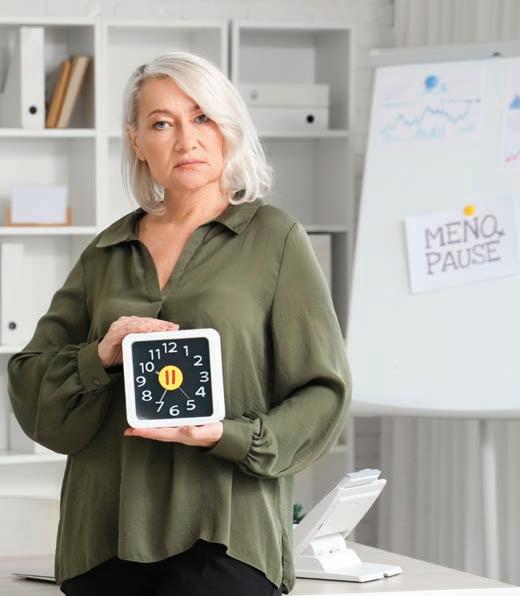
In June, a large-scale study by Tufts University sought to determine the health benefits of caffeinated and decaffeinated coffee with and without the addition of sugar and saturated fat. The results published in The Journal of Nutrition suggest that drinking a lowto-moderate amount of caffeinated coffee daily lowers the risk of all-cause mortality; however, the benefit drops when an overabundance of sugar and saturated fat are added.
The researchers analyzed data from the National Health and Nutrition Examination Survey conducted between 1999 and 2018 involving more than 46,000 American adults. Individuals that consumed one to three cups every day were about 15 percent less likely to die in the next nine to 11 years compared to those that did not drink coffee at all. This benefit was negated for those that added more than half a teaspoon of sugar, one tablespoon of half-and-half, or three-and-a-half tablespoons of whole milk. Drinking decaffeinated coffee was not associated with healthy aging.

According to research published in Nature Metabolism, the calorie-free sweetener known as sucralose may increase appetite. Sucralose is widely distributed in various food products, including baked goods, beverages, chewing gum and frozen dairy desserts. In a randomized crossover trial involving 75 young adults, participants consumed a beverage containing sucralose, sucrose or water.
The study revealed that the sucralose-containing drink could stimulate appetite by delivering a sweet taste without triggering the body’s natural mechanism for suppressing hunger. While this study is unlikely to significantly alter the availability of sucralose, it aligns with the 2023 World Health Organization’s recommendation that non-sugar sweeteners should not be used for weight management purposes.
Determining how fast a brain ages may help predict and prevent dementia, a condition that is projected to impact approximately 42 percent of Americans aged 55 and older, according to the National Institutes of Health. While genetic analysis at the cellular level offers insights into biological age, its application to brain cells is hindered by the blood-brain barrier, which prevents cell collection.
Researchers from the University of Southern California have devised a non-invasive method that integrates magnetic resonance imaging (MRI) with artificial intelligence (AI) to assess brain aging. Their findings were published in Proceedings of the National Academy of Sciences of the United States of America.
The AI database was constructed through an exhaustive analysis of thousands of brain scans from individuals with different brain conditions and varying ages. Subsequently, patient brain scans taken at distinct time intervals are compared to the database to identify brain zones that are exhibiting accelerated aging. The method was tested on more than 100 adults with healthy brains and 140 Alzheimer’s patients. The researchers are optimistic that their approach will not only identify early signs of cognitive decline but also facilitate the prediction of disease progression.


As many vehicles advance toward automation, passengers are presented with a range of new possibilities. Without a human driver, the car’s interior can be transformed to cater to the desires of the traveler with entertainment, media and digital connections seamlessly integrated into the vehicle’s ecosystem. Routes can be customized to optimize the journey, ranging from the quickest to the offbeat, with the ability to identify interesting and historically significant landmarks, locations, features and objects along the way.
In the car of the future, integrated artificial intelligence assists in planning scenic detours and dining experiences. Because the vehicle drives itself, enhanced lie-flat seating that incorporates massage and optimal body positioning ensures passengers arrive at their destination feeling well-rested. High-quality audio and video systems, coupled with atomizers that release the occupants’ favorite aromatherapy scent, provide an opportunity to enhance the overall sense of well-being. Biometric sensors monitor heart rate and stress levels, prompting relaxation or meditative activities. Companies such as Cadillac and BMW are already working to make these concepts a reality.

Julee Herdt, an award-winning architect, inventor and professor of architecture at the University of Colorado, has developed a range of high-performance, sustainable building materials called BioSIPs. Herdt’s technology enables the construction of structural panels, beams, interior partitions and furniture from paper, agricultural and bovine waste, as well as unwanted biomass such as hemp, wood and aromatic flowers, eliminating the need for synthetic binders or toxic resins. She has also developed insulation made from mushrooms that bonds to the BioSIP products.
These building materials are fully renewable, repulpable and recyclable. In a full-scale test, a solar home constructed with BioSIP
Perfluoroalkyl and polyfluoroalkyl substances (PFAS), commonly referred to as forever chemicals, have been linked to a number of health concerns. In April 2024, the U.S. Environmental Protection Agency labeled a specific PFAS known as perfluorooctane sulfonic acid (PFOS) and its salts and isomers as hazardous chemicals.
Scientists from the UK’s University of Oxford and Colorado State University have developed a novel method for both destroying PFAS and reusing some of their elements in new products. Their method, published in the journal Nature, involves reacting PFAS with potassium phosphate salts and then grinding the PFAS and salts together using ball bearings to break the carbon-fluorine bonds. This process facilitates the reuse of the fluorine content in the manufacture of medicines and other products.

products outperformed standard and sustainably designed solar homes in terms of energy efficiency, environmental standards and occupant comfort.
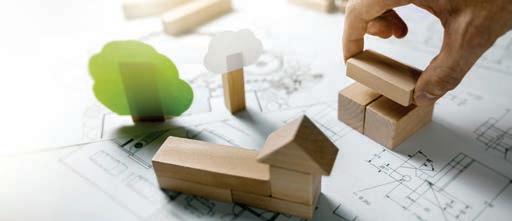
by Carrie Jackson
Harmony in our daily routine provides a sustainable and fulfilling rhythm. A life in balance accommodates ambition and rest, effort and ease, honoring our individual energy and purpose. Instead of pursuing future goals and equating success with monetary gain or accomplishments, we can learn to appreciate the present moment and align our choices with personal values. By shifting from a rigid, externally oriented idea of success to a more holistic, harmoniously driven approach, we can experience greater joy, purpose and authenticity.
In 2022, Yoli Maya Yeh, a yoga teacher, shiatsu therapist and educator whose work revolves around Indigenous preservation, healing arts and social justice, embarked on an adventure of global nomadism and worldschooling her now 13-year-old child. Their journeys have taken them to many countries, including Morocco, Italy, Malta and Senegal. Yeh asserts that her lifestyle was not the result of a single decision but rather the culmination of focus, willpower and the strength of those that have walked before her.
“While entrepreneurship flows through my veins, without a clear vision, a sense of purpose and a deep well of confidence, I would not be able to be this assertive and daring in my approach to how I want to fulfill my dreams. I could decide to play small and feel contracted in my body, but that was not the intuitive guidance I have come to trust,” Yeh explains. “My vision is a life where I can be in spaces of belonging,
collaborating and problem solving, dreaming and world-building our collective liberated future. In the present moment, I explore my inborn gifts and hone them to be of maximum service.”
She maintains that a path of development cannot be solely cerebral, sharing, “A traveling lifestyle provides me with a high level of changefulness in which I can cultivate growth and adaptation through constant new experiences that challenge me to navigate unknowns. We must bring the transformative process into the body through active restoration tools and meaningful engagement with self.”
Harmony and resistance are felt in the body, and tapping into those signals enables us to deeply connect with our true selves. As Yeh puts it, “Perpetual analysis in the mind disconnects us from the experience of
resonance, thus distancing us from actual alignment. A daily centering practice that draws on a collage of breathwork, mantra and meditative techniques allows us to hone our connection to the sensations in the body.”
As a respite from the demands of modern society, Yeh turns to yoga nidra, a yogic sleep meditation originating in South Asia, as well as other Indigenous wisdom traditions. “Living in the modern era presents us with contradictory factors,” she says. “We have more automation and digital support, while at the same time, we are cut off from our ancestral rejuvenation practices such as sacred dreaming, ritual and community celebration.”
Another valuable practice is rematriation, or “returning to the Sacred Mother”, which emphasizes the restoration of Indigenous knowledge and connection. “In this practice,

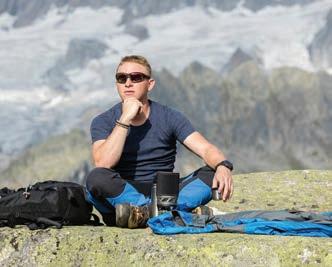
we lay our tired bones down on the earth to rest and revive the ancestral wisdom that lives within. Like so many meditative and trance practices, one explores liminal states of consciousness where the mind expands well beyond the confines of the awake, thinking mind and amplifies creativity and a sense of freedom,” Yeh explains. “To experience fulfillment in life, we need a recipe that combines resonance of expansion and a sense of belonging. Success is the embodied expression of this connection to self and collective at the same time.”
Brianna Wiest is the bestselling author of numerous books, including 101 Essays That Will Change the Way You Think, The Pivot Year and The Mountain Is You. Her personal reflections are derived from years of self-inquiry and meditation practice, and her writing emphasizes emotional intelligence and self-awareness as keys to meaningful success.
She notes that the conventional standard of success varies depending on an individual’s upbringing, network and environment. “There are ways in which society measures and corroborates a concept of success, and many people feel beholden to this definition. But this can become more defeating than motivating, as the idea of success is often divorced from the essence of what it should actually mean,” she says. “Success is effective ness, but the question becomes: Effectiveness at what? Fulfillment is when we’re effective at something meaningful. It’s an internal gauge, rather than an external measure. Fulfillment is when we feel deep peace and inner satis faction, regardless of how others may perceive our endeavors or pursuits.”
Shifting the focus away from the outcome, and more on our journey, is a practice that strengthens within the interplay of momentum and inertia. Wiest states, “The more we acknowledge and feel good about the progress we’re making, the more inclined we feel to make more of it. Often, we use the inverse on ourselves: We try to focus on the ways in which we’re falling behind (or imagine that we are) so as to motivate ourselves to move forward. This usually just compounds the mindset that we are incapable, and it’s not worth the effort. The best way to become more of anything is first to find evidence of the ways in which you already are that thing.”
Wiest recommends striking a balance between ambition and rest by fine-tuning intuition and strengthening the ability to respond effectively. “There’s no right way to divide up your time, and everyone’s needs differ,” she points out. “Rather than waiting until you’re at the point of depletion to think about taking care of yourself, sit honestly with the question of where you’d like your bandwidth to expand and how your body and mind signal that it’s time to decompress. In the same way that you have to rest a muscle after exercising it for it to strengthen, repair and grow, the rest of the body works similarly. It’s part of the process, not antithetical to it.”
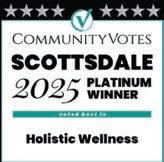

Spiritual Development Classes and Intuitive Workshops
Private Healing and Psychic Reading Sessions
Psychic Development and Reiki Classes (including CEs for Massage Therapists)
Guided Meditations for Intention and Clarity

Amazing Gifts and One-of-a-Kind Treasures https://DimensionsofHeavenandEarth.com 11108 N. Frank Lloyd Wright Blvd., Suite #E-16, Scottsdale, AZ 85259 (732) 832-1036
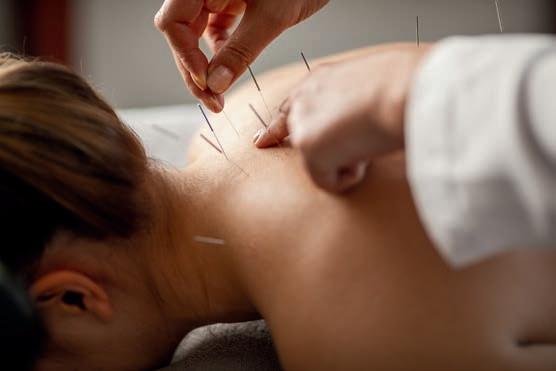


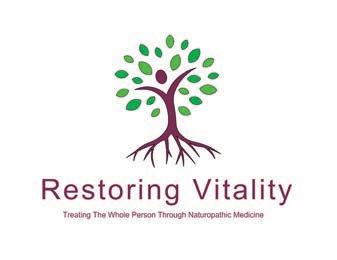



Reflective practices such as meditation and journaling can enable us to be more mindful and make decisions that align with our values, instead of acting impulsively. Wiest suggests looking at life from the perspective of our 90-year-old self and considering what we would have done differently. “Mindfulness is a way of both stilling the waters of the mind and calming the inner chaos, while at the same time, giving us the chance to pause between having a thought and a feeling and then immediately responding to it,” she says. “It’s that gap of time where we get to consciously decide how we will react that ultimately creates our personal freedom.”
Author, podcaster and co-founder of the Dharma Coaching Institute, Sahara Rose Ketabi helps people discover their soul’s purpose. “Your dharma is the big reason why you are here,” she explains. “It’s your sacred mission, your truth and the sacred intersection of your joy and the world’s needs. When you’re aligned with your dharma, life begins to feel like a divine dance—yes, with challenges, but also with deep meaning. It’s not about being the best at something; it’s about being you, fully and unapologetically.”
Ketabi contends that the pursuit of success alone does not yield happiness; it is happiness that brings true success. “Success isn’t just about ticking boxes or climbing ladders. It’s about alignment,” she clarifies. “We can shift this mindset by tuning into our bodies, emotions and passions, asking, ‘Does this feel expansive? Does this nourish my soul?’ When your success is in service of your dharma, it feels sustainable, fulfilling and soul-led.”
Ketabi incorporates Ayurvedic wisdom into her teachings to help people tune into their own energy. “Ayurveda is the science of life, and your dharma is the reason you’re alive. They’re inherently connected. By understanding your dosha—vata, pitta or kapha—you understand your strengths, challenges and soul gifts,” she explains. “It’s not just about food or herbs; it’s about rhythm. If you’re a fiery pitta trying to force your purpose, you may burn out. A dreamy vata may need structure to bring ideas through. Ayurveda teaches you how to work with your energy, not against it, so your dharma can blossom naturally.”
Living as your most authentic self ultimately has a butterfly effect for making positive changes in the world. “When one person lives in their dharma, it shifts the field for everyone around them. It creates a ripple of remembrance,” says Ketabi. “I believe that your dharma is not just about you, but it’s about the impact you create through being you. It is not selfish to follow your joy; it’s necessary. When you do what you love, you become magnetic. You inspire others to stop settling, to heal and to rise. You become the permission slip they didn’t know they needed. Living your dharma is the highest form of spiritual activism.”
Carrie Jackson is a Chicago-based freelance writer and frequent contributor to Natural Awakenings. Connect at CarrieJacksonWrites.com.
Baking soda (sodium bicarbonate) is a versatile and economical household cleaner and personal care product that offers numerous benefits. Its non-toxic and biodegradable properties make it an environmentally friendly choice.
• Kitchen Surfaces: Sprinkle on a damp sponge to clean countertops, sinks and greasy stovetops. Adding a few drops of tea tree, lemongrass, peppermint or orange essential oil will enhance the antibacterial properties.
• Pots and Pans: Use as a gentle abrasive to scrub pots and pans—even stainless steel.
• Drains: Pour half a cup of baking soda followed by half a cup of white vinegar down the drain. Allow it to fizz, then rinse with hot water. This is not a substitute for clearing clogs.
• Laundry Booster: Add half a cup to a load of laundry to soften the water, boost detergent effectiveness and neutralize odors. This natural solution is safe to use with baby items.


• Bathroom Fixtures and Surfaces: Mix an equal amount of baking soda and water or vinegar to form a paste for scrubbing sinks, tubs, tile and grout. For a deeper clean, combine with Castile soap instead of water or vinegar.
• Toilets: Use as a powdered cleanser, adding a few drops of a germ-fighting essential oil such as lavender, tea tree or lemon.
• Carpets: Mix a cup of baking soda with a few drops of geranium, lavender or ylang ylang essential oil and sprinkle it evenly over the carpet. After half an hour, vacuum thoroughly.
• Natural Deodorizer: Place an open box in the refrigerator to keep it smelling fresh. Sprinkling baking soda in garbage cans, shoes or gym bags can help eliminate unpleasant odors.
• Produce Cleaner: Mix one teaspoon of baking soda per two cups of cold water and soak strawberries or other produce for 12 to15 minutes. Gently rub the fruit or vegetables, then rinse thoroughly with clean water and pat dry. This method can reduce dirt, bacteria and some pesticide residues.
• Sterling Silver Polisher: Combine two tablespoons of lemon juice or distilled vinegar with two tablespoons of baking soda.
With a soft cloth, gently rub the mixture onto sterling silver items and rinse thoroughly. Allow more tarnished items to soak in the mixture for a few minutes before cleaning.
• Teeth Whitening: Sprinkle a small amount of baking soda on the palm of the hand, dip a damp toothbrush into the solution and brush as usual. This method should only be used sparingly, as baking soda can damage tooth enamel.
• Skin Relief: Add half a cup of baking soda to a bath to soothe skin irritation. This solution is beneficial for eczema, poison ivy and dermatitis.
• Hair Cleansing: Mix a small amount of baking soda with water to create a solution. Massage the mixture onto wet hair and rinse thoroughly. This shampoo alternative helps to reduce excess oil and buildup of styling products, restore pH levels, treat dandruff and lighten hair dye. It can also serve as a dry shampoo by simply combing it through dry hair. Long-term or excessive use is not recommended, as baking soda’s abrasive properties can cause split ends, irritate the scalp and strip hair of natural oils.

by Chris Condon, DC
Most people struggling to conquer chronic back or neck pain have come to our clinics as a last resort hoping to avoid surgery. For 20 years in Massachusetts, we were known as the go-to place for nonsurgical spinal corrective care for pain syndromes driven by scoliosis, stenosis, abnormal alignment and various degrees of disc disease, including degeneration/dehydration, bulging and disc herniation. We became the place to go when everything else failed.
Now we practice in Scottsdale and have brought our advanced techniques and technologies with us. At Ally Spine Center, we focus on the structural causes of spine pain and make changes to the anatomy with pain-free treatments that help to eliminate pressure on joints, discs, nerves and the spinal cord. We have found over the years that very few patients have experienced true spinal decompression but have instead opted for simple mechanical traction disguised as decompression. The key to advancing care and delivering results that help patients avoid surgery is in the understanding and execution of the processes that allow for true spinal change that can be verified with before-andafter imaging studies.
Ally Spine Center is the only provider in Arizona with true spinal decompression utilizing the most advanced system, the SpineMed. With the SpineMed, we are able to effectively, efficiently and painlessly target the spinal-discnerve level to alleviate pressure and create the necessary vacuum within the spinal disc to

restore its proper structure and function. Once patients understand the true cause of their chronic spine pain and see how quickly and safely they can find relief without surgery and lengthy rehabilitation, they are quite surprised and wonder why they hadn’t heard about this technique sooner.
We explain to our patients that the current model of care for these spine conditions is designed to chemically alter their pain response to the underlying condition. We also explain that this approach will always lead to progressive decay and need for further treatment. Unfortunately, many patients fall into this category and lose their ability to enjoy life. Ultimately, the symptom-treatment model leads to surgeries and more disability. A PubMed search reveals Medicare guidelines and research statistics showing that 70 percent of spine surgeries are unnecessary, 68 percent may require a second or even a third surgery in the same region, 75 percent of patients experience the same pain after surgery, and the overall long-term success rate is only 8 to 12 percent.
The landscape of health care in the U.S. is constantly evolving, revealing that less invasive procedures for spinal care are safer, more economical and more effective. With
an approximately 90 percent success rate in overall pain-relief and correction of underlying structural damage with nonsurgical spinal decompression and class 4 laser therapy (and ongoing in a four-year follow-up study, McClure, et al), we often see the most chronic cases improve and avoid surgery.
The SpineMed’s precise delivery of very lowforce distraction to the affected spinal level(s) is unmatched in the field of medical equipment. With more than 20 years of experience in taking on cases of severe chronic pain, sciatica, stenosis, disc herniation and even peripheral neuropathy (50 percent of cases also have disc-nerve contribution), we are able to make unparalleled changes and can greatly shorten the curve of getting patients back to living life actively and without restrictions. Our recommendation is simply this, “Noninvasive/spinal corrective care first, drugs/injections second, and surgery last.” Find out sooner, rather than later, that by addressing causes before treating effects, your body can heal itself.

Dr. Chris Condon has owned and operated multiple clinics in the greater Boston area and now in Scottsdale at Ally Spine Center. He is also a speaker, health coach, nutritional consultant and author. He can be reached at 480-809-4700 or visit AllySpineCenter.com.
Advertorial

Conscious Eating
by Chloe Karydes Krecun
Microgreens and sprouts are small but mighty, delivering considerable benefits for the health conscious. Whether grown at home or purchased fresh from a local grocer or farmers market, these superfoods make for an easy and accessible way to add texture, flavor and nutrients to everyday meals.
Subtle differences distinguish these two remarkable plants. Microgreens are edible, immature seedlings grown in soil or a similar medium and harvested upon the appearance of the first few cotyledon leaves. Sprouts are germinated seeds that are cultivated in water until they grow into an edible plant. Their roots, seeds and leaves are edible.
“Anyone can grow a small tray of microgreens on a windowsill or around a kitchen counter,” says Katie Staudt, owner and head grower of Meraki Urban Farm, in Chicago. She points out the

common misconception that microgreens can only be grown in a liquid solution. While some do-it-yourself kits employ hydroponic techniques, they are not the most efficient growing method and may lead to mold growth.
“You don’t have to have a green thumb if you have the right information,” says Staudt. Because they can be easily propagated in small trays, microgreens are ideal for small, indoor spaces. She suggests using soilless media made of peat, coconut coir or hemp that allow for proper drainage while holding the right amount of moisture. The plants demand little maintenance and are usually harvested when the greens are one to three inches tall, making them a perfect choice for individuals with limited gardening experience. Staudt recommends beginning with the radish sprout, which can grow and be ready to eat in as little as seven days. Kale, purple kohlrabi, red acre cabbage, bok choi and wasabi mustard sprouts are also easy-to-grow varietals.
Sprouts can be more challenging to grow because they require greater oversight to preserve food safety. It is important to soak the seeds in water and rinse them daily with clean water to maintain a moist environment while also reducing the risk of bacterial growth. According to agricultural experts at Penn State Extension, bacteria in the sprouting seeds “can continue to thrive if proper food handling techniques are not practiced during harvest, processing and preparation.”
The U.S. Food and Drug Administration provides good agricultural practices for growing, harvesting, packing and holding sprouts, which include using clean water, wearing disposable sterile gloves when handling the seeds and sprouts, and cooling the sprouts to 32° F immediately after harvesting. The FDA strongly recommends cooking sprouts thoroughly before consuming them to eliminate harmful bacteria. Children, the elderly, pregnant women and persons with weakened immune systems should avoid eating raw sprouts altogether.
According to Dominique Kline, farm manager of The Hope Farm, in Alabama, “Radish or broccoli sprouts would probably be the easiest ones to start out with at home, just because those are some of the most reliable and have the fastest turnover.” Alfalfa, mung bean and sunflower sprouts are also relatively easy to grow.
According to the U.S. Department of Agriculture, microgreens contain five times greater levels of vitamins and carotenoids than their mature plant counterparts, including vitamins C, E, K and A, as well as beta carotene, lutein/zeaxanthin and violaxanthin.
“You can eat 50 cups of broccoli or a single cup of broccoli sprouts for similar nutrition and benefit,” explains Emily Ho, nutrition professor and director of the Linus Pauling Institute at Oregon State University, in an article published by the American Heart Association.
It is important to understand that these plants’ shelf life is short once they are cut. “The closer they are to being alive, the better they are for you,” Kline asserts. For those that prefer to purchase their produce
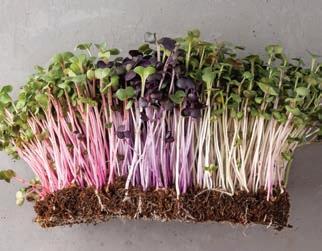
Einladung_zum_Essen from pixabay/CanvaPro
instead of growing it, local farmers markets or select grocery stores also offer fresh microgreens and sprouts that provide the same nutritional benefits and quality. This can be a convenient way to not compromise on freshness or effectiveness.
Not only are microgreens and sprouts relatively simple to grow, they are even easier to eat. Incorporating them into meals is quite straightforward. Kline recommends adding them to any hot or cold food as an easy nutrient boost. Sprinkle them on salads, eggs or pizza for added texture, contrast and flavor. Arugula and radish microgreens add a delightful peppery flavor, while mung beans offer a milder, slightly sweet experience, and sunflower sprouts lend a nutty flavor to any dish.
Whether enjoyed fresh from a windowsill at home or sourced from a local market, microgreens and sprouts bring nutrient density along with delicious flavors and textures, making them an attractive green to incorporate into everyday meals
Chloe Karydes Krecun is a sophomore at University of Illinois Urbana-Champaign. Connect at LinkedIn.com/in/ chloe-karydes-krecun.
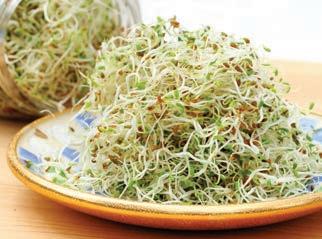

GenAI/CanvaPro
YIELD: 1 SERVING
1 cup frozen organic berries
1 cup coconut water
1 frozen banana
1 oz broccoli microgreens
2 Tbsp hemp seeds or chia seeds
Place all ingredients in a blender and blend until smooth. Pour into a glass and enjoy immediately.
Recipe courtesy of Katie Staudt.
Einladung_zum_Essen from pixabay/ CanvaPro

GenAI/CanvaPro
YIELD: 2 TO 3 SERVINGS
1 can chickpeas, chilled and drained ¼ cup tahini
2 Tbsp olive oil
1 tsp lemon zest
4 Tbsp fresh lemon juice
4 Tbsp water
1 tsp tamari or liquid aminos
¼ tsp sea salt or smoked salt
¾ cup sunflower sprouts or mixed sprouts
6 cherry tomatoes, halved
Handful of fresh basil leaves
Combine chickpeas, tahini, olive oil, lemon zest, lemon juice, water, tamari or liquid aminos and salt in a blender. Pulse blender a few times then blend ingredients until smooth. If the hummus is too thick, add another tablespoon of water. Transfer hummus to a bowl.
Add tomatoes, basil leaves and a thick layer of sprouts on top of the hummus. Drizzle everything with olive oil, an extra splash of fresh lemon juice and a sprinkle of tamari.
Enjoy with bread, pita, crackers or spooned over a bed of freshly made quinoa, couscous, lentils or a green salad.
Recipe courtesy of Marlaina Donato. Connect at WildflowersAndWoodSmoke.com.
by Christina Connors
In an era when children are growing up in digital landscapes unfamiliar to many parents, establishing connections can feel like navigating a maze. But harmonious living is attainable through small, intentional moments that cultivate trust and emotional safety. Rather than solely emphasizing control or screen-time restrictions, deeper bonds can be created by tuning in with curiosity, presence and empathy. Here are some strategies that parents and caregivers can employ to bridge the gap and foster connection.
“For decades—perhaps centuries—children have received consistent messaging about emotions: control them, contain them and, whenever possible, conceal them. This approach wasn’t necessarily malicious; it reflected cultural values that prioritized stoicism and social harmony. The ‘good child’ was often the quiet child, the composed child, the one who didn’t ‘make a scene’,” says Lee Sowles, founder and CEO of Kind Mind, a program that teaches adults and children how to co-regulate, be kind and feel ready to learn. “When we support our kids’ emotions, we teach them that all feelings are valid—even the difficult ones—and then we can empower them with the skills they need to process emotions in healthy ways. This fosters trust, emotional resilience and a more harmonious home environment where everyone feels seen and safe, which is crucial because children thrive when they feel understood and connected.”
To communicate effectively and foster positive exchanges with our children, it is critical to keep emotions in check. According to Janet Philbin, a clinical social worker, certified conscious parent and life coach, as well as the author of Show Up for Yourself: A Guide to Inner Awareness and Growth, if a child comes to us upset, crying, whining or demanding, the best response is to remain level-headed and attentive.
“Pausing and tuning in allows us to come into harmony because we are moving from a sympathetic state of fight/flight to a state
of calm and presence,” she says. “We are regulated, and our child can come to us with their emotions, feeling safe. We do not react; instead, we become grounded and present, allowing us to meet our child where they are and tune in to what they need, which is underneath the behavior we’re seeing. This is how harmonious relationships are created, because we have regulated our nervous system, and our child can regulate theirs.”
An effective method to foster mutual trust and respect with a child is with a shared journal in which parents and kids are able

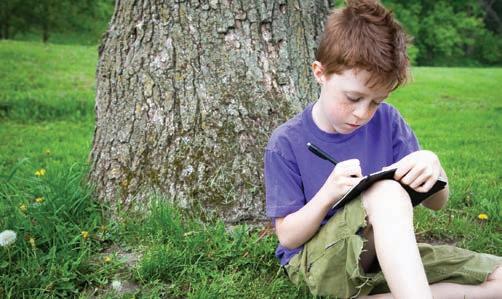
to communicate with each other through the written word. “Using the journal creates space to respond from a place of our loving hearts without judgment and putting aside the need to fix,” explains Philbin. “Our children will feel heard and safe, ultimately creating harmony in the relationship.”
Philbin shares how her family makes use of a shared journal, noting, “Our kids write to us about what they are struggling with and leave the journal for us in a safe space. When we find the journal, we take our time to respond to our child. In that response, we can let them know we hear them, that their feelings matter and that their struggle is real. We stay away from solving the problem, and instead just let them know that we are supporting them to work it through. Then we hand the child back the journal, and this process continues.”
Building a robust connection with a child doesn’t require grand gestures. Instead, it is about creating consistent, small moments that build an emotional rhythm. Here are a few suggestions:
• Make it a habit to take screen-free walks after dinner.
• Regularly journal about a common prompt—such as recounting a memorable or unexpected event—and then read the journal entries out loud to each other.
• Find opportunities to share common interests and spend quality time together, perhaps by playing the child’s favorite board game or video game.
Living harmoniously, particularly in parenting, is not solely about achieving balance, but also about cultivating presence. When we approach our children with empathy, curiosity and intention, we do not merely hear them; we genuinely see them. In this act of seeing, connection begins.
Christina Connors is a writer, singer and creator of a YouTube series for children. Learn more at ChristinaConnors.com.




by Marlaina Donato
From the haunting drone of an Australian didgeridoo to the steady heartbeat of a frame drum, cultures around the world have used sound to facilitate healing for thousands of years. In modern times, scientific research corroborates what native cultures have intuitively known: Sound-based vibration and resonance affect our body at the cellular level.
“As you consider the efficacy of sound vibration in the body, it is important to understand that our cells, organs, bones, tissue and cerebral spinal fluid are all composed of water. We are more than 70 percent water, and sound travels four times faster in water than in air. The human body is a natural resonator for sound,” says Ellen F. Franklin, Ph.D., co-founder and chief executive officer of the Acutonics Institute of Integrative Medicine, in Llano, New Mexico, who draws from East Asian medicine, Western science, psychology, physics and music theory to provide sound vibration therapies.

The use of Tibetan or crystal singing bowls, percussion instruments, calibrated tuning forks, gongs, cymbals, chimes, flutes and vocalization affects brain waves by inducing parasympathetic relaxation and modulating pain perception. Directly impacting the vagus nerve, strategic sound applications can alleviate symptoms of depression, anxiety, chronic pain and trauma response, and can be useful for those suffering from post-traumatic stress disorder. Improved sleep quality, heightened creativity and inner calm are additional potential benefits.
Histotripsy, a new U.S. Food and Drug Administration-approved technology, employs high-pitched, focused ultrasound energy to break up liver tumors. Similarly, lithotripsy uses ultrasonic shock waves to eliminate kidney stones. Acoustic engineering has also emerged as a promising tool for diagnosis, encompassing brain seizures, heart disease modeling and medication screening.
According to Franklin, co-author of Acutonics From Galaxies to Cells: Planetary Science, Harmony and Medicine, the vagus nerve can be activated via the application of calibrated tuning forks crafted from aerospace-grade metal to key acupuncture points along the body’s meridians (energy pathways). “A number of studies have shown that the vagus nerve is particularly sensitive to sound vibration. DU 20, a key acupoint, addresses stress and trauma, as it can be used to help people wake up the brain and open the mind, and is often used for cognitive disorders and many stress-related symptoms,” she explains, adding that this work is currently being used in clinical settings for patients that do not respond effectively to conventional methods or exhibit drug resistance.
The rhythmic patterns of electrical activity in the brain produce distinct frequencies that are associated with mental states, emotions and cognitive functions. Throughout our waking and sleeping life, the brain shifts through gamma, beta, alpha, theta and delta states. When we transition to the alpha state using sound therapies like drumming, binaural beats, singing bowls or gongs, we feel calmer and more joyful. Either by playing or listening, therapeutic hand drumming synchronizes the left and right hemispheres of the brain and may be valuable in augmenting cognitive function, retraining the brain after a stroke or improving the management of conditions such as autism, Alzheimer’s disease and attention-deficit hyperactivity disorder.
“The frame drum can significantly influence brain waves, primarily through a process called rhythmic entrainment. The pulses of the drum, especially when played at specific tempos, can induce the brain to synchronize with these rhythms, leading to shifts in brain wave patterns,” says Michael McCullough, a sound healing practitioner at The Healing Sanctuary, in West Chester, Pennsylvania.
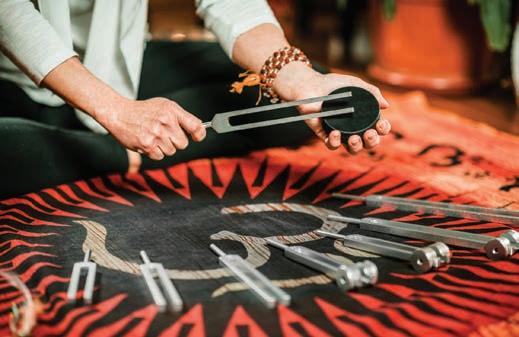
“Using the perfect fifth, or a 128 Hertz, tuning fork can also boost the body’s production of nitric oxide and balance the autonomic nervous system, releasing antibacterials, antivirals and free radicals on a microscopic level.”
Incorporating therapeutic sound modalities in our healing regimens can broaden the potential for physical and mental well-being. McCullough recommends trying a group sound bath, which is a meditative session where participants lie on a yoga mat or blanket and listen to a diverse range of sounds. He acknowledges that private sessions with a skilled practitioner may also be beneficial because they can be tailored to individual needs and provide a more comprehensive experience.
While Franklin also recommends such sound healing experiences, she cautions, “Frequencies can be used to promote health and wellbeing, but we always advise people to educate themselves. When working with sound medicine therapeutics, less is more.” Excessive sound therapy—too much or too often—could aggravate the nervous system in some individuals, causing unpleasant side effects such as dizziness, fatigue, disorientation or headaches.
Marlaina Donato is an author, musician and painter. Connect at WildflowersAndWoodSmoke.com.
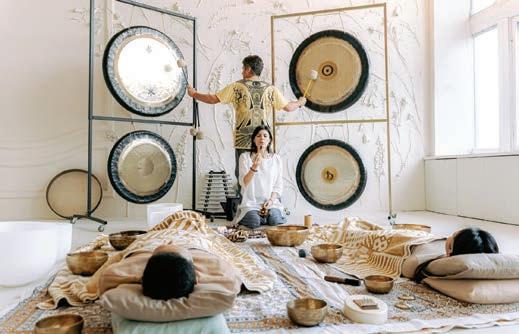

by Ruth Roberts, DVM, CVA, CVH, CVFT, NAN
Cats are often seen as low-maintenance companions, but they may still need supplements to support their health and well-being. The feline supplement market is one of the fastest-growing segments in pet health, with an expected annual growth rate of 8.7 percent through 2029. With so many available options, choosing the right supplements requires careful consideration.
Melissa Sherman, a holistic pet health coach and nutritionist, notes that the increasing interest in feline supplements stems from two primary reasons: a shift toward integrative wellness and a heightened emphasis on the unique needs of cats. “People are looking beyond conventional care and asking what more they can do to help their cats thrive, not just survive,” she explains.

A recent survey of pet parents conducted by market research publisher Packaged Facts reported that 76 percent of dog and cat owners were interested in finding health and wellness products for their pets. Nearly half of the respondents said that they were paying closer attention to their pets’ health in the aftermath of the COVID-19 pandemic.
According to the American Veterinary Medical Association, the number of U.S. households with at least one cat grew from 25 percent in 2016 to 29 percent in 2022. As more families welcome cats into their homes, interest in long-term feline wellness continues to rise. An aging pet population and the growing availability of veterinarian-formulated supplements further contribute to this rising trend.
To promote general feline wellness, Sherman’s top supplement recommendations fall into the following three categories:
1. Immune Support: Medicinal mushrooms such as reishi, turkey tail and shiitake are rich in beta-glucans, which help modulate the immune system and reduce inflammation.
2. Omega-3 Fatty Acids: Marine-based sources such as anchovy or krill are preferable. “Cats are obligate carnivores,” Sherman explains. “It’s essential they receive bioavailable, animal-based omega-3s rather than plant-based sources, which are harder for them to convert.” These nutrients contribute to skin health, joint function, cardiovascular well-being and cognitive performance, making them indispensable for cats of all ages.
3. Emotional Wellness Support: “Cats are deeply sensitive creatures, and their emotional state directly affects their physical health,” says Sherman. “Supplements that support the nervous system, including certain adaptogens or vibrational remedies like flower essences, can be incredibly helpful, especially for cats dealing with anxiety, transitions or trauma.”
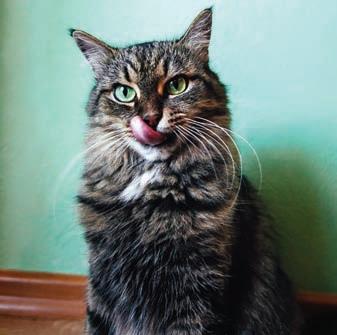
Beyond the foundational supplements, others can be added on a case-by-case basis as specific needs arise. Sherman recommends a comprehensive assessment of the animal’s diet, lifestyle, health history and symptoms, noting, “I evaluate food quality and variety, energy levels, digestion, coat condition and behavior. If the cat thrives on a balanced, species-appropriate diet with no signs of imbalance, supplements may be needed only for foundational support like omega3s. Life stage and unique needs are also considered. Kittens, seniors, stressed cats or those recovering from illness often benefit from targeted supplementation to optimize their health.”
In cases of chronic kidney disease, hyperthyroidism or taurine deficiency, especially
in cats fed home-cooked diets, targeted supplements may be necessary. These situations often require meticulously adjusted nutrient levels and additional support, such as glandulars (organ-based supplements) or adaptogens (stress-modulating herbs), tailored to the cat’s specific condition. In such cases, oversight by a veterinarian and/or nutritionist may be advisable.
Supplements are often viewed as a quick fix for health issues. Without addressing root causes such as poor nutrition or unresolved medical conditions, supplementation may lead to poor results. In some cases, they may even mask symptoms rather than support true healing. “One of the most important things to understand is that supplements can’t replace a high-quality diet or proper veterinary care. They’re powerful tools, but they work best as part of a holistic wellness plan,” says Sherman.
A common misconception is that more supplements are better. Cats often thrive with less. “Over-supplementation can strain organs like the liver and kidneys and may even contribute to the very issues we’re trying to resolve,” Sherman explains.
“Just because something is natural doesn’t mean it’s always safe or necessary. Cats are incredibly sensitive, and even beneficial ingredients can become harmful if used improperly.”
The selection of supplements should be purposeful and precise. Fat-soluble vitamins A and D can accumulate in the body over time and lead to toxicity. According to VCA Animal Hospitals, vitamin A toxicosis in cats, often caused by excess raw liver or supplement intake, can result in joint pain, lethargy, weight loss and skeletal deformities.
When selecting cat supplements, Sherman recommends looking for those made with high-quality, naturally derived ingredients and no synthetic additives or fillers. Choose species-appropriate formulations and brands that employ good manufacturing practices. Companies that share third-party testing results are best.
Exercise caution with essential oils, particularly those incorporated into other supplements, as they can be harmful to cats if not used properly. It is best to work with a professional experienced in essential oil use for animals.
Learn more about Dr. Ruth Roberts’ approach to holistic pet care and wellness at DrRuthRoberts.com.

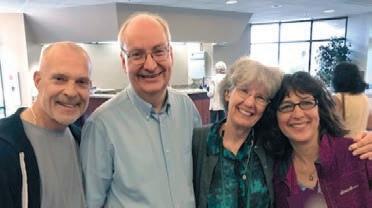

by Megy Karydes
The spaces we call home hold untapped potential to become powerful allies in our pursuit of wellness and tranquility. Creating a truly restorative environment goes beyond incorporating organic cotton throws and essential oil diffusers. The secret lies in recognizing that homes are living entities rather than mechanical constructs for shelter.
The human eye instinctively gravitates toward the soft curves and organic forms found in natural settings. Social psychologist Erich Fromm coined the term biophilia to describe an intrinsic affinity between living things. In architecture, biophilic design aims to create living spaces that foster well-being through a connection with nature.
One way to mimic nature indoors is through the use of curves and organic shapes, according to Lauren Riddei, a wellness interior

designer and founder of Haus Holistics, in Myrtle Beach, South Carolina. For instance, consider replacing angular coffee tables with round styles or swapping rectangular mirrors for curved versions.
Riddei recommends starting with one curved element at a time, making it “a goal that any new piece of art, furniture or accessory brought into the space has curves in them.” The recent trend toward rounded furniture reflects our innate craving for spaces where energy flows freely, unobstructed by sharp corners where it tends to get stuck.
Color psychology extends this natural approach beyond shapes. Rather than following fads, hues should be chosen based on current life needs, according to Lisa Morton, a holistic interior designer and founder of Pure Living With Lisa Morton. “Maybe the client doesn’t need calm. Maybe they’re in a rut and need revitalization, in which case they need oranges, yellows and pinks,” she advises, adding that if the primary objective is to create a soothing environment, blues, greens and creams should be considered.
Morton also recommends that homeowners follow the seasonal rhythms as a way to “remind our body of being outdoors even when we can’t be.” For example, during the fall and winter months she incorporates chunky rugs and throws crafted from natural fibers. As she explains, such textures resonate with the earth element of feng shui— the ancient Chinese practice of creating harmonious living spaces— thereby creating a sense of stability and grounding.
The Bagua Map, a feng shui blueprint for energy centers, charts a path for establishing harmony throughout the home. “The centermost area of your home connects to every other important energy center,” Morton asserts. “By lifting the energy of your center area, it affects every other part of your home.”
This intentional care radiates outward. Identifying the home’s center point (imagine a bird’s-eye view of the floor plan) and showering it with attention involves replacing burned-out bulbs, thoroughly
vacuuming, fluffing pillows and adding thriving plants or fresh flowers. “If your whole home feels stuck and stagnant, and you do work on this living area, it’s going to radiate out,” she remarks.
According to Morton, the front door deserves equal attention, because in feng shui, it is associated with new opportunities and fresh energy. “A lot of people don’t use their front door. They come and go through the garage,” she observes, recommending that people find ways to regularly use the front door—whether walking the dog or taking morning strolls—as a way to invite new, restorative energy into the home. Shaking out welcome mats, ensuring the smooth functioning of locks and adding seasonal wreaths all contribute to this goal.
Licensed therapist turned interior designer and author of Home Therapy Anita Yokota takes this intentional approach further with her concept of “core desire”. Rather than making design decisions first and

seeing how they make inhabitants feel, she flips the process by asking, “How do you want to feel and be in this space? What relationships do you want to thrive here?” This therapeutic approach ensures that every choice serves deeper needs, rather than following external trends.
Another overlooked aspect of holistic
home design is sound. While homeowners may obsess over visual elements, they often ignore how acoustic pollution affects well-being. “We are sensitive to loud noises and vibrations,” Riddei says. “We need an environment that won’t keep us on edge when we come home from a long day.” Her unconventional solution involves wind chimes tuned to the healing frequencies of 432 or 528 Hertz (Hz), which she asserts are associated with peace and love. This is particularly helpful for people that live on a noisy road.
Research published in the journal Health found that music tuned to the frequency of 528 Hz significantly reduced stress after only five minutes of listening. For those sensitive to auditory stimulation, Yokota suggests implementing additional insulation or sound-absorbing wall panels.
Megy Karydes is a Chicago-based writer and author of 50 Ways to More Calm, Less Stress.
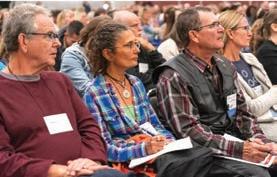



Make a meaningful impact in your community by becoming the owner of a Natural Awakenings magazine. Empower others with current, valuable insights and resources to enhance their physical, mental, emotional and spiritual well-being.
As a franchise owner, you’ll inspire positive change, provide readers with tools for healthier living and connect local businesses with an audience eager for transformation.
Why Own a Natural Awakenings Magazine?
n Create a Healthier Community: Be the go-to resource for wellness and personal growth in your area.
n Boost Your Income: Take control of your financial future with a proven business model.
n Enjoy a Flexible Lifestyle: Work from home while pursuing a fulfilling, dynamic career.
n A proven business model with low startup costs.
n Comprehensive training and friendly, ongoing support.
n Flexible work schedule with many work-from-home opportunities.
n Access to a network of like-minded franchise owners.
n Financing Options Available.
Join a thriving network of passionate franchise owners reshaping the future of holistic health and wellness.
Call 239-206-2000 for a FREE evaluation of your community’s potential. Learn more or apply today at:
Corp.NaturalAwakenings.com
Add Your Community to Where Natural Awakenings Is Now Publishing:
• Atlanta, GA
• Boston, MA
• Broward County, FL
• Bucks/Montgomery Counties, PA
• Central Florida/Greater Orlando, FL
• Central New Jersey
• Charlotte, NC
• Chicago, IL
• Columbia, SC
• Dallas, TX
• Daytona/Volusia/Flagler Counties, FL
• Detroit/Wayne County, MI
• Fairfield & Southern Litchfield Counties, CT
• Grand Traverse Region/Northern Michigan
• Greater Ann Arbor, MI
• Greater Lansing, MI
• Greater Oakland, Macomb, Livingston, Genesee, MI
• Gulf Coast, Alabama/Mississippi
• Houston, TX
• Jacksonville/St. Augustine, FL

• Lehigh Valley, PA
• Long Island, NY
• Milwaukee, WI
• Monmouth/Ocean Counties, NJ
• Naples/Fort Myers, FL
• New York City, NY
• North Central New Jersey
• North New Jersey
• Northwest Florida
• Palm Beach, FL
• Philadelphia, PA
• Phoenix, AZ
• Rhode Island
• Richmond, VA
• Sarasota, Manatee, Charlotte and DeSoto Counties, FL
• South Central Pennsylvania
• South Jersey, NJ
• Southeast North Carolina
• Space & Treasure Coast, FL
• Tampa, FL
• Tucson, AZ
• Twin Cities, MN
• Westchester/Putnam/Dutchess, NY
• Western Michigan Call for a free evaluation of your community's potential at 239-206-2000. To apply or learn more, visit Corp.NaturalAwakenings.com.
• Lancaster/Berks, PA

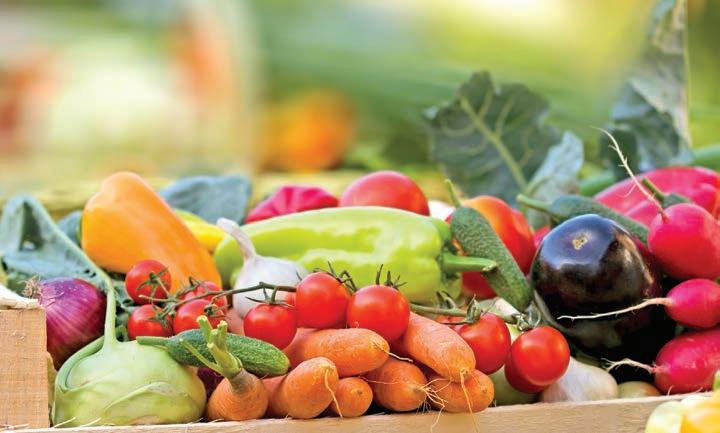
NOTE: Please check market websites and ArizonaCommunityFarmersMarkets.com for more information on days and hours, and any restrictions.
Ahwatukee Farmers Market
4700 E Warner Rd, Phoenix
Sundays Oct-May 9am-1pm Jun-Sep 8am-11am
Facebook.com/AhwatukeeFarmersMarket
Carefree Farmers Market
1 Sundial Circle
Fridays Oct-May 9am-1pm Jun-Sep 8am-11am
Facebook.com/CarefreeFarmersMarket
Downtown Chandler Farmers Market
3 S Arizona Ave
Saturdays Oct-May 9am-1pm Jun-Sep 7am-10am
DowntownChandler.org/events/farmers-market
Downtown Mesa Farmers Market
1 E Main St
Saturdays 8am-noon dtMesaFarmersMarket.com
Downtown Phoenix Farmers Market 720 N 5th Street
Saturdays Oct-May 8am-1pm
May-Oct 7:30am-11:30am DowntownPhoenixFarmersMarket.org
Gilbert Farmers Market
222 N Ash St
Saturdays Oct-Apr 8am-noon May-Sep 7-11am GilbertMarket.com
High Street Farmers Market
5415 E High St, Phoenix
Sundays Oct-May 9am-1pm
Facebook.com/Farmers-Market-on-HighStreet-2244771575799425
Mommas Organic Market
Arrowhead Farmers Market
7780 W Arrowhead Towne Center, Glendale
Saturdays Oct-Apr 9am-1pm | May-Sep 8-11am
Facebook.com/Getlocalazfarmersmarkets GetLocalArizonaEvents.com
Mommas Organic Market
Glendale Farmers Market at Cabela’s 9380 W Glendale Ave, Glendale
Sundays Sep-May 10am-2pm | closed for summer Facebook.com/Getlocalazfarmersmarkets GetLocalArizonaEvents.com
Ocotillo Farmers Market
2577 W Queen Creek Rd, Chandler
Sundays Oct-May 9am-1pm ArizonaCommunityFarmersMarkets.com/ ocotillo-farmers-market
Old Town Scottsdale Farmers Market
3806 N Brown Ave
Saturdays Oct-Apr 8am-noon, May-Jun 7-10am
Facebook.com/OldTownScottsdaleFarmersMarket
Power Road Farmers Market
4011 S Power Rd, Mesa
Monday-Saturday 9am-5pm | Sunday 9am-4pm PowerrdFarmersMarket.com
Roadrunner Park Farmers Market
3502 E Cactus Rd, Phoenix
Saturdays Oct-May 8am-noon | Jun-Sep 7-10am
Facebook.com/RoadrunnerParkFarmersMarket



Singh Meadows Farmers Market 1490 E Weber Dr
Fridays, Saturdays & Sundays 8am-2pm
Facebook.com/SinghFarms
Sun City Farmers Market 16820 N 99th Ave
Thursdays Oct-May 9am-1pm Facebook.com/Sun-City-Farmers-Market631299790224049
Uptown Farmers Market 5757 N Central Ave, Phoenix Wednesdays Oct-Apr 9am-1pm & May-Jun 8am-noon
Saturdays Nov-Apr 8am-1pm & May-Oct 8am-noon
UptownMarketAZ.com
Verrado Community Farmers Market N Market Pl & W Main St, Buckeye Sundays Oct-Jun 9am-1pm Facebook.com/VerradoCommunityFarmersMarket
Farmers Market in Old Town Square 1042 N Main St, Cottonwood Wednesdays 3-7pm (check months/times throughout year)
Facebook.com/FarmersMarketatOldTownSquare
Flagstaff Community Farmers Market 211 W Aspen Ave, City Hall Parking Lot Sundays May-Oct 9am-1pm FlagstaffMarket.com
Prescott Farmers Market
Dignity Health, YRMC 900 Iron Springs Rd, Miller Valley Lot Saturdays Nov-Mar 9:30am-12:30pm Apr-Oct 7:30am-noon PrescottFarmersMarket.org
Sedona Community Farmers Market
Wells Fargo Bank Parking Lot 2201 W State Rte 89A, West Sedona Sundays May-Oct 8am-noon Nov-Apr 11am-3pm Sedona-Farmers-Market.com
Verde Valley Farmers Market Hollamon St and Main St, Camp Verde Saturdays May-Oct 8-11am Facebook.com/VerdeValleyFarmersMarket
Windmill Park Farmers Market
9950 E Cornville Rd, Cornville Thursdays 2-6pm (check months/times throughout year)
Facebook.com/WindmillParkFarmersMarket



Connecting you to the leaders in natural health care and green living in our community. To find out how you can be included in the Business Directory, email PhoenixAds@NaturalAZ.com to request our media kit.
ARIZONA LEECH THERAPY
c Gershkovich, CHP, CRP, PMP, Therapist 8765 E Bell Rd, Ste 110, Scottsdale 480-621-6041 • ArizonaLeechTherapy.com ArizonaLeechTherapy@gmail.com

Pavel Gershkovich, owner of Arizona Leech Therapy, is a professional medicinal leech therapist. He is here to help you find a natural, drug-free solution for your medical conditions, such as cardiovascular, high blood pressure, migraine, urology/ prostate, varicose veins, and deep venous thrombosis. See ad, page 23.
LEADING EDGE WELLNESS
MacKenzie Kalt, Owner/Director 4050 E Greenway Rd, Ste 5, Phoenix 480-594-5052 • MyLeadingEdgeWellness.com

Providing some of the most advanced natural technologies for those struggling with chronic pain, injuries, stress, migraine headaches, PTSD, insomnia, Lyme disease, autoimmune disorders, skin conditions, and much more. Visit our website to learn more. See ad, inside front cover.
NATURAL MEDICINE & DETOX
2701 N 7th St, Phoenix 602-307-0888 • NaturalMedicineDetox.com

We offer a wide range of services that can help just about everyone at affordable prices. We also accept insurance for acupuncture, including Medicare. Please take a look at our website to learn about our services, gifted practitioners, and insurance information and form to see if your plan covers acupuncture. See ad, page 14.
NAMASTE BOOKKEEPING
Jen & Mark Arnold 480-442-8208
JandM@NamasteBookkeeping.com
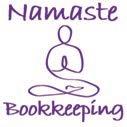
You are passionate about the work you do! It’s not a job; it’s a mission, a calling, a ministry. And it lights you up! There is nothing you would rather be doing. You make a difference! Let us help you so you can help the world!
ALLY SPINE CENTER
10565 N 114th St, Ste 109, Scottsdale 480-809-4700 • asc.drc2000@gmail.com AllySpineCenter.com

Dr. Chris Condon utilizes stateof-the-art techniques and technologies including non-surgical spinal decompression with the SpineMed and SUMMUS class 4 medical laser for the correction of degenerative spinal conditions including stenosis, herniated/bulging discs and neuropathy as well as knee decompression with the Knee On Trac.
NATURAL DENTAL PARTNERS
6930 E Chauncey Ln, Ste 100, Phoenix 602-775-5120 • MyNaturalDentist.com



The doctors at Natural Dental Partners take the time to listen to your concerns and use their extensive experience to help you achieve better health. Using the latest technology (such as low-dose 3D imaging, CEREC, lasers, PRF, ozone and treatment of sleep disorders), they believe in a team approach to help you achieve your healthcare goals. Check out MyNaturalDentist.com or ABreathOfHealth. com to see how they can help you. See ad, page 3.

Dr. Josh Raiffe, DMD, AIAOMT 11111 N Scottsdale Rd, Ste 120, Scottsdale 480-998-3923 • SheaDentalAZ.com

Shea Dental offers holistic dentistry led by Dr. Josh Raiffe, DMD, AIAOMT Accredited. Using advanced technology like CEREC milling, digital impressions, Wand anesthesia, cone beam CT scanning, and SMART mercury filling removal, Dr. Raiffe ensures safe dental practices. Services include implants, veneers and sleep apnea treatments. Accepts most dental insurance. See ad, page 5 and 17.
SACRED LIGHT OF COSMIC AWARENESS COMMUNITY 480-273-4577 • SacredLight777@proton.me SacredLightCommunity.com

Reclaim your power. Identify your soul purpose. Spiritual healing an d self-realization workshops. Channeled messages from the Divine Creator. Free PastLife Readings. Develop psychic clarity, inner trust, strength and confidence; examine hidden unconscious patterns; and engage in personal power management, karmic healing, calming the mind and dream interpretation.
OSTEOSTRONG
8120 N Hayden Rd, Scottsdale Text/call 602-932-2792 OsteoStrongScottsdale.com

OsteoStrong is a leader in natural bone health and wellness with centers in Phoenix (Arcadia) and Scottsdale (McCormick Ranch). Our m embers report significant improvements in osteoporosis, physical strength, balance and posture in 15 minutes a week. Specializing in osteogenesis without drugs, we’re dedicated to holistically enhancing quality of life. See ad, page 4.
PRECISION BONE IMAGING
Locations in Phoenix and Scottsdale 888-415-7377
PrecisionBoneImaging.com

Precision Bone Imaging is the #1 Echolight REMS provider in the U.S., offering a more accurate, radiationfree alternative to DXA for bone density and quality assessments. REMS technology delivers a comprehensive assessment, helping you prevent osteoporosis or monitor your bone health baseline with confidence.
RESTORING VITALITY CLINIC
Paw Kamwee, NMD 34470 S Old Black Canyon Hwy Black Canyon City
623-374-9498 • Restoring-Vitality.com

At Restoring Vitality, we blend the best of modern science with time-honored natural healing techniques to provide a comprehensive and integrative approach to your wellness. We believe in empowering our patients to take control of their health, and we are committed to providing the guidance and support you need to achieve your wellness goals. See ad, page 13.
ANDREA BRIGGS, AKA “CRITTER DOC”
ASAM, Sh Reiki, HTAP Communicator, Healer, Counselor 602-317-1543 • 1CritterDoc@gmail.com SpiritAnimalWisdom.com

With a gentle healing touch, Andrea provides wellness counseling, energy healing, animal communication, and intuitive counsel for pets and their people.
HEALING ARTS
1538 E Southern Ave, Tempe 480-994-9244
Info@swiha.edu • swiha.edu

Nationally accredited college offers holistic health and wellness degrees, diplomas, certificates of excellence, continuing education and personal development, oncampus and online. Financial aid available. See ad, outside back cover.
OF
11108 N Frank Lloyd Wright Blvd, Ste E16 Scottsdale • 732-832-1036
DimensionsOfHeavenAndEarth.com

Dimensions of Heaven and Earth is Scottsdale’s exciting, new one-stop Spiritual Experience: a center of healing and insight combined with a store full of unique gifts from local artisans. With training and tools for your personal development, we are excited to help you take your spiritual journey to new levels! See ad, page 13.
The Path of Spiritual Freedom 1-877-300-4949 • EckankarArizona.org Eckankar.org • HearHU.org Facebook.com/EckankarArizona

Eckankar is an active, individual, creative spiritual practice. A companion and roadmap for your journey home—to the heights of Self-Discovery and GodDiscovery, and beyond. Come along and discover the most secret part of yourself. The key to spiritual freedom lies within you. Explore life as a Soul Adventure. See ad, page 25.







